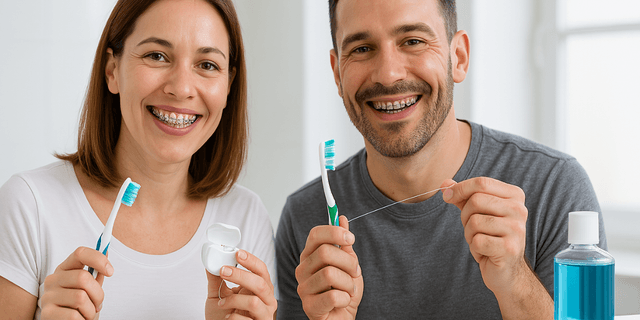Orthodontics
How to Clean and Care for Your Retainers
Retainers are an essential tool for maintaining the alignment of your teeth after orthodontic treatment. Keeping them clean and in good condition is critical to their effectiveness and your oral health.
7 min read
Feb 06, 2025

Retainer Reality Check
The day your retainer arrives is the day your smile graduates from braces boot camp. Congratulations—your teeth are finally in the right spot and you’d like them to stay there for life. But that plastic-and-wire hero only works if you respect it. Retainers are essential because they hold your teeth in place while bone and gum tissue settle. Skip the upkeep and those lower front teeth you fought so hard to straighten may wander back to their old hangout. Think of your retainer as a loyal friend: treat it well and it will stick around; ignore it and it might ghost you.
Clean Your Retainer Every Day
It’s important to clean your retainer at least once every twenty-four hours. A quick rinse knocks off last night’s breakfast crumbs, but deeper gunk—hello, plaque and bacteria on your retainer—needs elbow grease. When you don’t clean, funky smells and white film build up fast. Want to clean without wrecking it? Use lukewarm water and a soft toothbrush (never hot; you’ll warp the plastic). For stubborn spots, add a pinch of baking soda to create a gentle scrub. Remember, a clean retainer feels smooth; rough patches signal mineral buildup.
Type of Retainer: Know Your Hardware
There are different types of retainers and each needs slightly different TLC. An Essix retainer (clear plastic tray) loves a gentle hand wash; a Hawley retainer (wire + acrylic plate) tolerates a mild soak; a permanent retainer (bonded wire behind the teeth) needs careful floss threading. Aligners and clear retainers look similar, but they’re cousins, not twins. Certain retainer materials scratch easily, so never use gritty toothpaste. When in doubt, ask your orthodontist which retainer cleaner is safest for your exact model.
Retainer Care Essentials
Proper retainer care starts the moment you place your retainer in its sturdy, vented retainer case. Keep your retainer away from curious pets—dogs think it’s gourmet chewing gum—and never tuck a retainer in a napkin at lunch. One absent-minded toss and your investment hits the trash. Handle your retainer with clean hands; oils from your fingers can invite more buildup. If your retainer doesn’t feel snug, schedule a checkup. The right retainer should click in without force; if you have to muscle it, something’s off.
Orthodontics and Life After Braces
Orthodontics doesn’t end when the brace comes off. You still have an orthodontic treatment plan—just a quieter one. Think of the retainer as the cool-down stretch after a marathon. Skipping it risks undoing months of straightening your teeth. Wear your retainer exactly as prescribed. If you need to wear a retainer full-time for six months, commit. Retainer wear drops to nights only once your orthodontist gives the thumbs-up.
Brace to Retainer: The Transition
That first night you put your retainer in your mouth may feel weird. It sits snug against enamel, and the plastic may taste faintly “new.” A hint of pressure is normal—it’s your retainer to help cement the positioning of your teeth. If a part of the retainer pinches or rubs, call your dentist; tiny adjustments keep the liner comfy and prevent sores.
Retainer Clean vs Deeper Clean Routine
A splash of water is a start, but every few days you’ll crave a deeper clean. Soak the retainer in distilled water with a teaspoon of white vinegar for about 15 minutes. (Any longer and the acid can roughen plastic.) Rinse the retainer thoroughly afterward so your morning coffee doesn’t taste like salad dressing. Prefer fizz? Drop it into an over-the-counter cleaner tablet bath, but stay within the recommended time—vinegar for about 15 minutes or tablet for ten keeps things safe. Too long and you could damage your retainer.
Orthodontic Experts on Cleaning a Retainer
Ask ten pros how to clean a retainer and you’ll hear the same mantra: soft brush, mild soap, lukewarm water. Harsh cleansers ruin shine and can even crack acrylic. Never boil or microwave; intense heat will surely warp the plastic. A dab of gentle toothpaste is fine for a quick scrub, but gritty, whitening pastes scratch clear trays. If you crave minty freshness, use alcohol-free mouthwash to clean for thirty seconds, then rinse.
Orthodontic Treatment and Long-Term Success
Your smile’s future hinges on consistency. Replace your retainer every couple of years, or sooner if you notice cracks, odor that survives every wash, or a poor fit. Retainers may stretch microscopically over time, and a loose tray won’t hold your teeth. Your orthodontist usually checks alignment annually, but call earlier if you feel gaps.
Clean Retainers on Busy Days
Racing out the door? A sixty-second routine keeps things sane: rinse, brush your retainer gently, quick rinse your retainer again, and pop it into the case. At night, give it the spa treatment—soak your retainer in a mild solution while you stream your favorite show. That’s efficient retainer maintenance without major effort.
Brush, Rinse, Soak
Three verbs, endless freedom. First, brush the tray with a baby-soft bristle—kids’ brushes are perfect. Second, rinse under running water to whisk off suds. Third, soak the retainer once a week in half cup water plus half teaspoon baking soda for five minutes; the alkalinity wipes out odors and brightens plastic. Don’t forget to clean your case with the same solution; there’s no point laying a pristine tray in a germ motel.
Removable Retainer Survival Guide
A removable retainer loves routine. Keep your retainer in its box whenever it’s not hugging your teeth. Avoid leaving the retainer outside on a hot dashboard—heat can turn it into modern art. If you leave your retainer on a sink, cats see it as a hockey puck. Lesson: always lock it away.
Keep Your Retainer Safe: Storage and Travel
Traveling? Tuck a back-up case plus travel-size cleaner in your bag. Airports are notorious for losing small things; a spare means you won’t have to hold your teeth with your tongue on a red-eye. Also pack a fold-up toothbrush so you can brush your teeth and tray mid-journey. Keep your teeth and gums clean, and your tray stays clear too.
Orthodontist Hacks for Stubborn Gunk
If you spot fuzzy white specks (hello, tartar) that won’t budge, mix equal parts water and white vinegar, soak for five minutes, then gently scrub. Still stuck? Ask your dentist to use an ultrasonic bath—it rattles off minerals without scratching. Never pick at resin with metal tools; you’ll create grooves where more gunk will accumulate on your retainer.
Soak Your Retainer the Right Way
Fill a glass with room-temp water and drop in the tray. Add one fizz tablet or a dash of baking soda; both lift stains. Never soak your retainer in mouthwash with alcohol—plastic dehydrates and cracks. Afterward, rinse, pat dry, and store. Remember, proper care extends lifespan and saves cash.
Wear Your Retainer, Love Your Smile
Need motivation to stick with nightly wear? Picture your teeth in their new perfectly lined-up parade. Quit early and they’ll shift. Wearing retainers keeps the victory line tight. If your retainer fits like day one, cheers—you’re winning.
Permanent Retainer Particulars
A permanent retainer is stealthy but tricky to floss around. Use a floss threader or water flosser daily; food trapped behind the wire rots and smells. Schedule hygiene visits twice a year; hygienists blast away hidden debris.
Wear a Retainer Without Stress
Life happens, and sometimes you forget to put your retainer in after dinner. If it feels tight the next morning, wear it for a few extra hours. Consistency beats perfection.
Fixed Retainers and Daily Upkeep
Fixed retainers stay put, so you must clean around them. Angle your toothbrush 45 degrees at the gumline, sweep gently, then floss under the wire. A tiny interdental brush is gold for squeezing between the lower front teeth.
Caring for Your Retainer on the Road
Whether camping or couch-surfing, pack a small bottle of distilled water. If sinks are questionable, store the tray retainer in distilled water until you can scrub properly. That keeps it hydrated and minimizes odor.
Different Types of Retainers Recap
From clear retainer trays to classic Hawleys, each has quirks. Retainers are made to hug enamel, but retainers are made of porous materials, so they soak up flavors. Invest a few minutes a day and your device stays invisible.
Retainer Maintenance Checklist
Retainer every morning: quick rinse under the tap.
Nightly: soft toothbrush scrub, mild soap.
Weekly: white-vinegar bath for a deeper clean.
Monthly: inspect for cracks; schedule a visit if needed.
Yearly: professional exam to ensure the retainer sits perfectly.
Random Pro Tips
Mouth-breathers see more dryness; sip water to keep trays moist.
Never use boiling water—it can warp the plastic beyond repair.
If you drop it on pavement, don’t risk germs; call for a replacement.
Always tell the office if the retainer needs adjusting after dental work.
For clear aligners, the cleaning rules are identical—just more often because you swap trays weekly.
Final Straight Talk
Your orthodontic journey may feel finished, but the maintenance phase is where lifelong smiles are forged. Take care of your retainer, and it will faithfully take care of you—quietly, invisibly, and with zero late-night emergencies. Straight teeth, healthy oral health, and a confident grin? Totally worth a two-minute scrub.
Read Next
Related Posts

Orthodontics
Caring for Your Braces: Cleaning Tips, Foods to Avoid, and Maintenance
Braces help correct misaligned teeth and improve your bite. They’re a long-term investment in your dental health, but they also require daily responsibility. Cleaning effectively, choosing the right foods, and keeping up with maintenance appointments will help protect your teeth and make your treatment go more smoothly.
6 min read
Apr 03, 2025

Orthodontics
Traditional Metal Braces vs. Modern Alternatives: Which Is Right for You?
Braces have become almost synonymous with orthodontics, but the choices available today go well beyond what many remember from childhood. Whether you're dealing with crowding, misalignment, or a bite issue, orthodontic treatment can improve both oral health and appearance. And while metal braces are still widely used, alternatives like clear aligners and ceramic braces have expanded what's possible in terms of comfort, aesthetics, and lifestyle compatibility.
11 min read
Apr 03, 2025

Orthodontics
Self-Ligating vs. Traditional Braces: Understanding the Differences
Today, patients typically choose between two main types: traditional braces and self-ligating braces. Both involve wires and brackets, but they differ in how they interact with the archwire and influence factors like comfort, maintenance, and overall efficiency. Understanding these distinctions can help patients make informed decisions about their orthodontic care.
9 min read
Apr 03, 2025
Don’t have time to research every dentist around you?
See why 30k+ patients trusted us